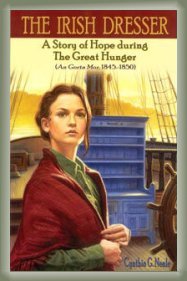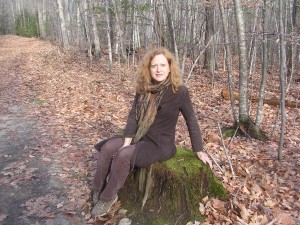by Pamme Boutselis
Cynthia Neale is an American writer of Irish ancestry, who has long been fascinated by the tragedies and triumphs of the Irish during the Famine. The author of two young adult historical fiction books and one adult historical novel, Neale is currently researching and writing her next adult historical novel, “Catharine, Queen of the Tumbling Waters,” about Queen Catharine, a Native American who once ruled a village that was destroyed by General John Sullivan in 1779. She also writes plays, short stories and essays. She says, “I seek to sew my stories together with the unbreakable golden thread of hope.”
Have you always been a writer?
I grew up in the beauty and fecundity of waterfalls, fields and rolling hills of the Finger Lakes region in New York State. I wrote poems, skits and stories beginning around age ten, entertaining family and neighbors with these stories. After high school, I took courses at Elmira College, Roberts Wesleyan College and eventually graduated from Vermont College with a B.A. and concentration in creative writing. I worked as a paralegal, freelance writer, fitness instructor and owned a Victorian tea catering business. I married and had a daughter and all the while, I wrote short stories and started a few novels.
Tell me about some of the publications you’ve written for beyond your own books.
I write a romance dance series for Set Dancing News magazine that is published out of Clare, Ireland. I’ve been an Irish set dancer for nearly twenty years and this writing springs from the colorful array of personalities I meet on the dance floor. I was a freelance writer prior to dedicating my time to writing fiction. No, I’ve never been published in any high profile magazines or newspapers, but my first real job was at The Beverly Hills Courier in Beverly Hills, CA where I worked as a typesetter. It was a fine introduction for a country girl with writing stars in her eyes.
I also worked for a small newspaper in Rochester, New York as an analytical writer. I had to write about the complex topics of physician-assisted suicide, prayer in schools, as well as the notorious Top Free Seven (feminists who bared their breasts in public parks). I researched the extreme sides of the issues and tried to splash color on black and white. I also wrote for a small suburban newspaper in Rochester and covered local interest stories. It was thrilling to see my articles about restaurants framed and displayed. And all those free dinners and drinks were wonderful as well.
I’ve had articles published in various magazines such as AMC Outdoors, a short story published in a Hampton, New York newspaper, and essays in the Rochester Shorts Magazine. However, as important as it was to be writing in any genre, it was fiction I desired to write since I was a young girl.
 Your first book, “The Irish Dresser: A Story of Hope During the Great Hunger,” is for young readers and focuses on the story of Norah McCabe, an Irish girl who makes her way to America. How did Norah’s story come to you and why did you want to tell it?
Your first book, “The Irish Dresser: A Story of Hope During the Great Hunger,” is for young readers and focuses on the story of Norah McCabe, an Irish girl who makes her way to America. How did Norah’s story come to you and why did you want to tell it?
Norah McCabe, the protagonist in my novel, Norah, came to me as a child of thirteen in my first children’s novel, The Irish Dresser, A Story of Hope During The Great Hunger (An Gorta Mor, 1845-1850). I had been roused to read all things Irish because heretofore I hadn’t been privy to the knowledge of my Irish heritage. As a writer, The Great Hunger period of Irish history grabbed me by the heart and wouldn’t let go. There has been horrid “ethnic cleansing” periods in world history, and this event (the worst disaster of the 19th century) was indeed the same. It was believed amongst some British government officials at the time that Providence had provided them a means, through the potato fungus and famine, to rid them of their nasty Irish problem.
I was astounded that the only knowledge of this event I had known came from a high school history book, “Over a million people perished in Ireland from the loss of the potato crop.” John Walters writes, “Surveys, I’m told, indicate that the Irish people do not want to hear about the Famine. But it is also precisely why the subject must be talked about until we remember the things we never knew.” As a writer with a heart beating fast for Irish dancing, as well as my history, I knew this was a subject that would become the vehicle for a story. There was no number tattooed on the Irish skin, but the marking of cultural shame was evident. Tom Hayden writes in Irish Hunger, “There are unmarked famine graves in all of us.”
In 1997, while dancing at an Irish pub, I looked up at the well-known poster titled, “Irish Dresser,” which is in every pub in Ireland and in a few pubs in this country. It is from a photograph taken in the 1960s of an 1800s Irish dresser (comparable to what we know as a china cabinet). On the dresser, there are china cups, a photo of JFK and the Pope, and a red hen scratching on the floor in front of big cupboard doors. As I danced, I imagined a young girl suffering from hunger and tragedy, but dreaming of a better life when she climbs inside this place of refuge, her hiding place, and place of hope. Norah McCabe eventually travels across the sea to America hidden away in this dresser. After I wrote the first book and found a publisher, I thought I was finished telling her story. But I couldn’t leave her on the shores of America, and I also learned through genealogical research that there was a real Norah McCabe who had come from Ireland to NYC in 1847.
The success of “The Irish Dresser” and the interest readers had in knowing more about Norah’s story led to “Hope in New York City: The Continuing Story of The Irish Dresser.” Did you know what Norah’s tale would be before the book came into fruition?
The prior response, I believe, answers this question as well. I felt strongly that Norah had more to tell me about her life as a young immigrant in NYC. And I was inspired because I was feeling the presence of the times and what it would be like for a young Irish woman fresh off the boat to arrive in NYC.
What has feedback been from young readers as well as parents and educators on your two books for young readers?
I have a box full of letters from students who wrote to thank me for writing these books. I’ve also had letters from educators as well. Making the past come alive through presentation and story is what students need to learn history. I bring in antique hats, wear immigrant clothing and make the past come alive for them. And I believe I’ve aroused empathy in them for immigrants and others who suffer from poverty and prejudice. One little boy came to me after I spoke and handed me some money with tears in his eyes. “Can I help now?” he asked.
In more recent time, you released your first book for adult readers, “Norah: The Making of an Irish-American Woman in 19th-Century New York.” Why did you move to this medium to continue this story?
In “Hope in New York City,” Norah finds a fragile identity as an American but she still struggles with longing for home. She feels more Irish than American and only near the end of the book does she find her dancing feet again. And it happens in a dance hall where African Americans and Irish dance together! This is real history and I was fascinated with the dance hall. I knew that this was where she would get in touch with her Irish self again. Norah meets Walt Whitman, goes to the Barnum Museum and survives the first theater riot in NYC.
But after I finished writing this book, I felt she was only beginning to know herself in a new country. She was just beginning to bloom and she also had her first experience with young love. There was more story brimming within me that I needed to tell. The period between post massive immigration and the Civil War is stocked full of events that ultimately define America’s struggle with feminism and racism. I wondered how someone like my Norah would see and experience these events. But I needed to tell her story as an adult, not as a child, because she had grown into a young woman. Each book stands on its own and it isn’t necessary to read them in a series (although it’s a richer experience to do so). The third book has adult themes and is set in the same period as “Gangs of New York,” mind you!
What takes longer for you, researching or writing the books?
I spend equal time researching and writing. There are visitations from my main character(s) through epiphanies and inspiration, but I try to convince myself I shouldn’t write a story. I think I’ll do just a little research, but I can’t stop and for years I take copious notes that fill legal pads. During this time, the flesh begins falling on the bones of my character(s) and I do a rough outline that fills out as I work. Immersed in the period, I time travel and feel I’m ready to begin writing.
Over the years, I’ve learned to let loose and write the story as it comes, rather than writing a page and going over it ten times. However, when I’m finished, I re-write numerous times. It is so crucial to re-write and edit, and delete extraneous material. I am reluctant to give up all the thrilling facts found in the historical period, but I must if it doesn’t support my story. I also have a friend who was a copy editor who goes through my novels with a fine-toothed eye comb.
Who do you feel has influenced your writing the most?
A slew of writers of the past, such as Louisa Mae Alcott, Thomas Hardy, Charles Dickens, D.H. Lawrence, Emily Bronte and Jane Austen.
How has your life been changed by writing?
“Writing is an affair of yearning for great voyages and hauling on frayed ropes.” ~ Israel Shenker
I rejected the heart nudge and the punch in the gut to write for many years and for many reasons. Once I began, I knew I couldn’t stop. And then it wasn’t me rejecting me, but being rejected by publishers and editors. But I was in the ring and although I was knocked down numerous times, I stayed there trying to master my moves around the page. It’s a rough business and I’m damned if I do and damned if I don’t. Steven Pressfield says, “The artist committing himself to his calling has volunteered for hell, whether he knows it or not. He will be dining for the duration on a diet of isolation, rejection, self-doubt, ridicule, contempt and humiliation.”
However, when you end up time traveling and feel as if you have been taken out of your own body and placed in your characters, it is glorious and better than any high you could artificially manufacture. And then creating compassion and empathy in young and old hearts through my stories is the most pleasing of all.
Category:
